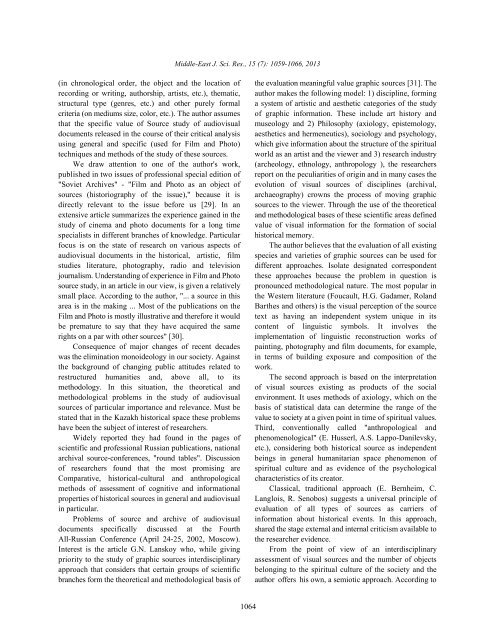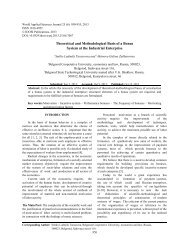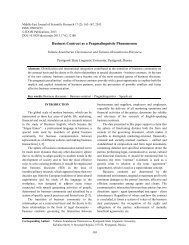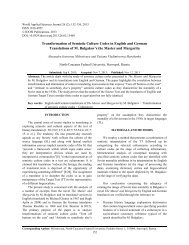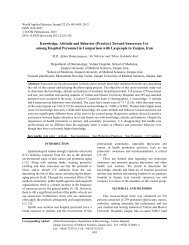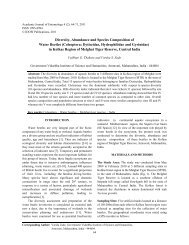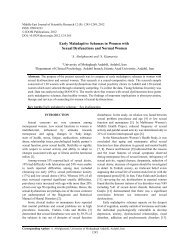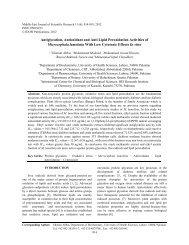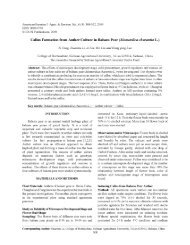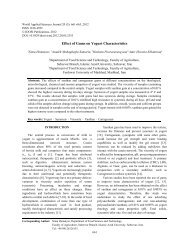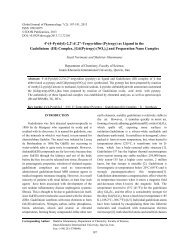Full Text - Idosi.org
Full Text - Idosi.org
Full Text - Idosi.org
You also want an ePaper? Increase the reach of your titles
YUMPU automatically turns print PDFs into web optimized ePapers that Google loves.
Middle-East J. Sci. Res., 15 (7): 1059-1066, 2013<br />
(in chronological order, the object and the location of the evaluation meaningful value graphic sources [31]. The<br />
recording or writing, authorship, artists, etc.), thematic, author makes the following model: 1) discipline, forming<br />
structural type (genres, etc.) and other purely formal a system of artistic and aesthetic categories of the study<br />
criteria (on mediums size, color, etc.). The author assumes of graphic information. These include art history and<br />
that the specific value of Source study of audiovisual museology and 2) Philosophy (axiology, epistemology,<br />
documents released in the course of their critical analysis aesthetics and hermeneutics), sociology and psychology,<br />
using general and specific (used for Film and Photo) which give information about the structure of the spiritual<br />
techniques and methods of the study of these sources. world as an artist and the viewer and 3) research industry<br />
We draw attention to one of the author's work, (archeology, ethnology, anthropology ), the researchers<br />
published in two issues of professional special edition of report on the peculiarities of origin and in many cases the<br />
"Soviet Archives" - "Film and Photo as an object of evolution of visual sources of disciplines (archival,<br />
sources (historiography of the issue)," because it is archaeography) crowns the process of moving graphic<br />
directly relevant to the issue before us [29]. In an sources to the viewer. Through the use of the theoretical<br />
extensive article summarizes the experience gained in the and methodological bases of these scientific areas defined<br />
study of cinema and photo documents for a long time value of visual information for the formation of social<br />
specialists in different branches of knowledge. Particular historical memory.<br />
focus is on the state of research on various aspects of The author believes that the evaluation of all existing<br />
audiovisual documents in the historical, artistic, film species and varieties of graphic sources can be used for<br />
studies literature, photography, radio and television different approaches. Isolate designated correspondent<br />
journalism. Understanding of experience in Film and Photo these approaches because the problem in question is<br />
source study, in an article in our view, is given a relatively pronounced methodological nature. The most popular in<br />
small place. According to the author, "... a source in this the Western literature (Foucault, H.G. Gadamer, Roland<br />
area is in the making ... Most of the publications on the Barthes and others) is the visual perception of the source<br />
Film and Photo is mostly illustrative and therefore it would text as having an independent system unique in its<br />
be premature to say that they have acquired the same content of linguistic symbols. It involves the<br />
rights on a par with other sources" [30].<br />
implementation of linguistic reconstruction works of<br />
Consequence of major changes of recent decades painting, photography and film documents, for example,<br />
was the elimination monoideology in our society. Against in terms of building exposure and composition of the<br />
the background of changing public attitudes related to work.<br />
restructured humanities and, above all, to its The second approach is based on the interpretation<br />
methodology. In this situation, the theoretical and of visual sources existing as products of the social<br />
methodological problems in the study of audiovisual environment. It uses methods of axiology, which on the<br />
sources of particular importance and relevance. Must be basis of statistical data can determine the range of the<br />
stated that in the Kazakh historical space these problems value to society at a given point in time of spiritual values.<br />
have been the subject of interest of researchers. Third, conventionally called "anthropological and<br />
Widely reported they had found in the pages of phenomenological" (E. Husserl, A.S. Lappo-Danilevsky,<br />
scientific and professional Russian publications, national etc.), considering both historical source as independent<br />
archival source-conferences, "round tables". Discussion beings in general humanitarian space phenomenon of<br />
of researchers found that the most promising are spiritual culture and as evidence of the psychological<br />
Comparative, historical-cultural and anthropological characteristics of its creator.<br />
methods of assessment of cognitive and informational Classical, traditional approach (E. Bernheim, C.<br />
properties of historical sources in general and audiovisual Langlois, R. Senobos) suggests a universal principle of<br />
in particular.<br />
evaluation of all types of sources as carriers of<br />
Problems of source and archive of audiovisual information about historical events. In this approach,<br />
documents specifically discussed at the Fourth shared the stage external and internal criticism available to<br />
All-Russian Conference (April 24-25, 2002, Moscow). the researcher evidence.<br />
Interest is the article G.N. Lanskoy who, while giving From the point of view of an interdisciplinary<br />
priority to the study of graphic sources interdisciplinary assessment of visual sources and the number of objects<br />
approach that considers that certain groups of scientific belonging to the spiritual culture of the society and the<br />
branches form the theoretical and methodological basis of author offers his own, a semiotic approach. According to<br />
1064


